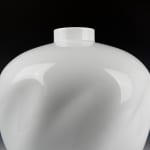Inoue Manji 井上萬二 b. 1929
H23.3 x Dia 25.4 x Lip Dia7.1 cm
Further images
Inoue Manji, like Imaizumi Imaemon XIII, hails from Kyushu but he represents the Arita tradition. Designated a Living National Treasure in 1995 for his work in white porcelain (hakuji) his work emphasizes form, and when decorated it is through subtle underglaze engraving or quietly playing with the forms through simple fluting.
Hakuji porcelain reveals all and hides nothing! This characteristic is well matched for Inoue’s perfectionist attitude when it comes to his ceramics. The flawless surfaces of his white porcelain leaves little room for error. Any blemish, flaw, or imperfection is glaring. These principles echo Chinese Song dynasty porcelain and Longquan celadon type wares, where flawlessness in form and surface were sought after. Some of his work references early Chinese porcelains but the two vases in this exhibition are straightforward pieces of white porcelain that rely on their gracious forms for their impact.
Inoue’s forms are single-minded pursuit of perfection in form and finish. They sometimes feature “hidden” patterns of flora and fauna in the celadon surface. This elusive decoration can be achieved only through celadon and other translucent glazes. The vessel’s beholder becomes lost in the pure white celadon glaze, while a delicately carved complex pattern gradually reveals itself within a landscape of flawless splendor.













